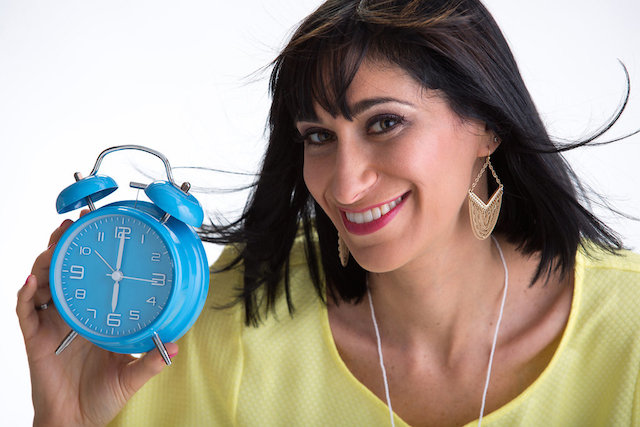It was not until she was already on her way to adulthood, that singer Sarah Aroeste discovered the connection between her Sephardic roots in Greece and her love of music with the Sephardic musical traditions in Ladino. Becoming a mother for the first time, she did not want her daughter to wait as to learn to love Ladino music. Not finding kid-friendly Ladino music, she did what any singer song-writer would do, she began to write her own!
The results of that effort will be out this month, with the release of Ora de Despertar – Time to Wake Up – a groundbreaking album of children’s music entirely in Ladino. Though it is the first of its kind for children, the album is also one of the few works made up of entirely new songs. Ladino was the language spoken by Jews, not only from Greece and Macedonia, like Aroeste’s family members, but throughout the Sephardi diaspora. Ladino was the language the Jews took with them from Spain when they were forced to flee in 1492. But over time fewer people use Ladino as an everyday language. “Although I didn’t grow up speaking Ladino myself, I heard my relatives speak it,” explains Aroeste, and she wanted to pass it on to the next generation.
“My desire in writing this album was to fill the gap,” she continues. “To share with my daughter music from her heritage that she would relate to. The way we transmit culture has changed so much. I’m incredibly worried that if we don’t start switching gears toward children and education, our beautiful Ladino tradition will get lost. For kids, the title track is simple, playful, but for us grownups, it’s a serious wake-up call.”
To do so, Aroeste created songs that touch on the topics that are fun for kids, balancing catchy tunes with content that adults will enjoy as well. There are animal sounds and mealtime songs as well as tributes to love and parenting. The arrangements are upbeat and engaging, with contemporary sounds and instrumentation, an approach that reflects Aroeste’s ongoing efforts to reinvigorate Ladino music and to write new material with centuries-old roots.
Studying in Israel, Aroeste learned the classical Ladino repertoire which has many ballads, with epic themes of high drama, sensuality, and family stories that were appropriate for singing around the table at big gatherings but were not necessarily child-friendly. The songs related to children’s experiences are few and far between, albeit gorgeous. “There are a few beautiful lullabies that a lot of people know,” explains Aroeste, “and there are some playful songs by contemporary songwriters like Flory Jagoda,” who wrote “Ocho Kandelikas,” a beloved Hanukkah tune.
Aroeste, however, envisioned something different, the kind of ditties she heard on the stack of albums friends and family gave her baby daughter. Little snippets of melodies came to the singer, who has won widespread acclaim for her virtuosic interpretations of traditional songs. But it took several years for the project to come to fruition.
“When I finally decided to go for it, I realized I’d never written for kids before, recalls Aroeste. “I had no idea what would fly. It’s a totally different style melodically, lyrically, to make music especially for children. I came up with a list of very general topics that I thought would work well for a children’s song, the words and concepts. ”
Finding the words, it turned out, was no simple task. Aroeste crafted the lyrics herself, then shared her drafts with Ladino native speakers. She uncovered a fascinating divergence of opinions: Someone from Rhodes would insist you had to say something one way, while someone from Izmir had a completely different idiom for the same thing.
“Finally,” Aroeste says, “one of my advisors told me to do what sounded best to me, as they were my poems, my songs. I had to make the decision for myself.”
In the end, Aroeste found the right turn of phrase to fit her sprightly melodies. Some songs are geared for the youngest listeners, filled with fun-to-sing lines (like “Mi famiya”), while some aim for more sophisticated, slightly older children, adding a bit of silliness to the learning process (such as “Nochada Buena”). Some of the most moving tracks chronicle Aroeste’s own moments as a mother and a mother-to-be. The lullaby “Kualo Tienes?” sprang from a particularly tear-filled evening, when Aroeste longed to soothe her little one, and “Komo vas a ser?” reflects Aroeste’s musings as she thought of her still in-utero daughter’s future.
Though it began with her family roots, the project has wide appeal. Aroeste envisions a broad audience for her newest venture, be they Jewish, Ladino-speaking, or simply curious. There are videos that Aroeste created together with a Spanish animator that go along with each song. She also has a songbook to make singing along a breeze, and plans to make board books adults can enjoy with youngsters.
“I feel so strongly about this album, this project,” Aroeste states. “There are no other Ladino resources for children, and people want them. They are interested in this culture and are struggling to figure out how to keep the tradition alive. I truly believe that cultural transmission will only happen if we get creative about the transmission process.”







